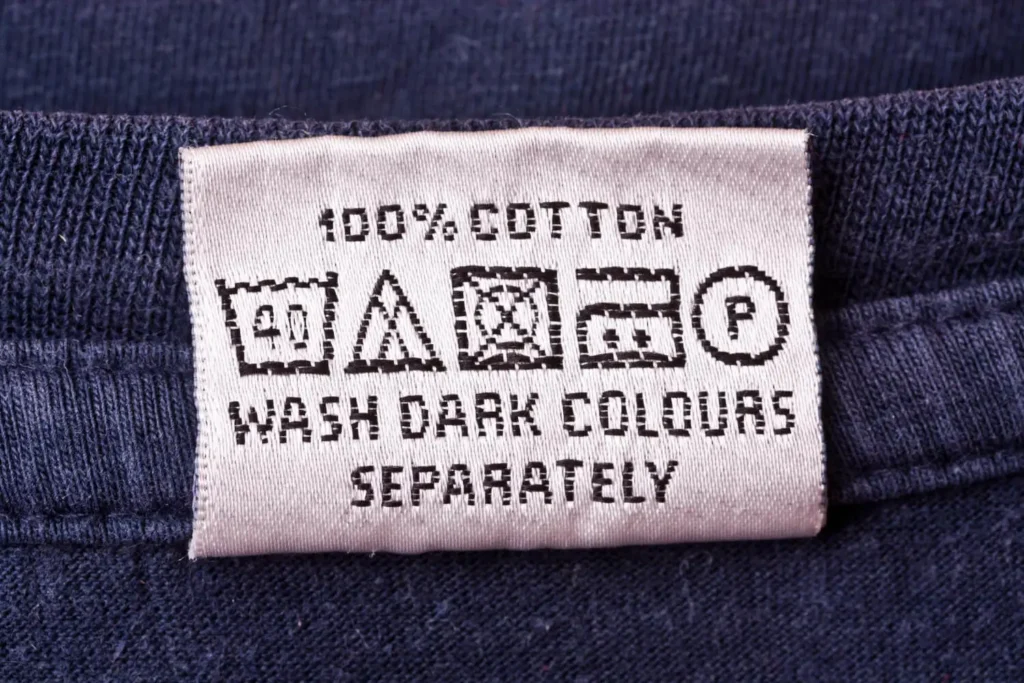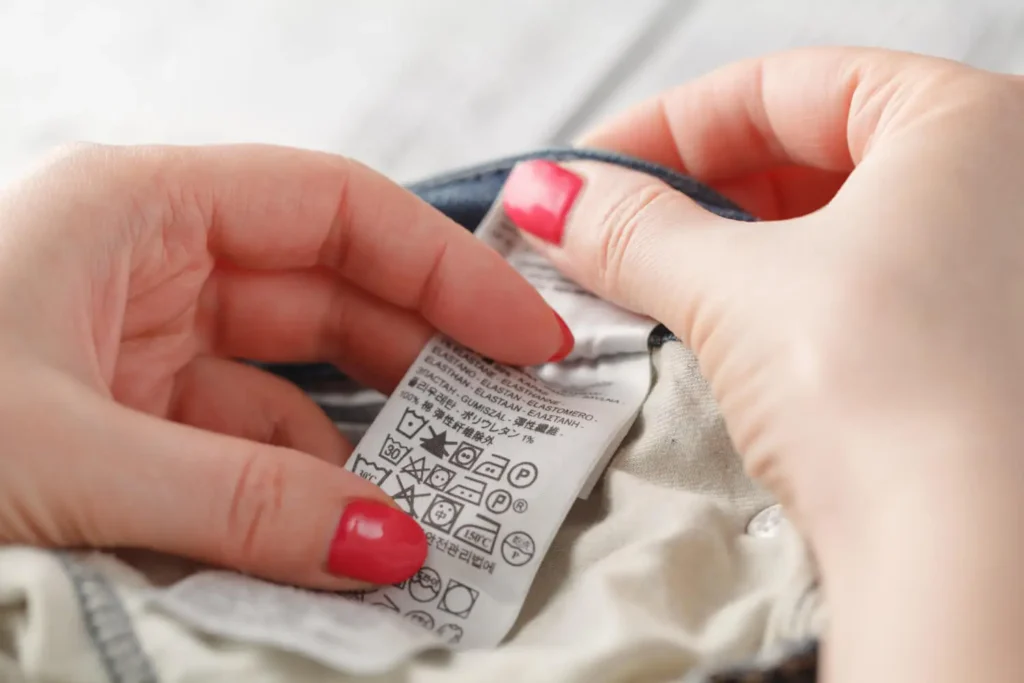Summary
- Clothing labels provide essential information, such as care instructions and material details.
- They build trust and showcase professionalism, so it’s vital to strictly adhere to regulations.
- Audaces360 offers all the solutions you need to streamline your production. Start your 15-day trial today!
Clothing labels might seem small, but they hold essential information. They tell customers how to care for their garments and what the items are made of.
For fashion companies, having the right labels is more than a legal requirement. It’s a way to show professionalism and build trust.
In this text, you’ll find everything you need to create accurate and informative labels for your clothing. Let’s start making your labels a valuable part of your fashion business.
Happy reading!
Sumário
Why is it so important to understand clothing labels?
For businesses, accurate labels show professionalism. They reflect a company’s commitment to quality and help build trust with customers.
Missing or unclear labels can cause frustration, and customers become less likely to return. In addition, failing to follow legal labeling requirements can result in fines or legal trouble.
Clothing labels also help companies meet industry standards and regulations. These requirements vary by country, but they always protect consumers and ensure product quality.
Understanding the regulations is key to avoiding issues and making sure your clothing complies with the law.
Clothing labels can also serve as a branding tool. With custom clothing labels or eco-friendly labels, businesses can showcase their brand identity while supporting sustainability.
Labels may seem small, but they are an important part of your product’s appeal.
What should your company know about label requirements?
Every fashion company must know the basic requirements for clothing labels to avoid legal issues and customer complaints.
These rules can differ depending on where you sell your clothes. So, it’s crucial to understand the regulations in your target market.
For example, the United States, Europe, and other regions all have different labeling standards.
It’s also important to choose the right type of label material. Custom clothing tags can have their origin from a wide range of eco-friendly materials.
This is a great way to reduce environmental impact. In addition, it appeals to customers who care about sustainable practices.
By following labeling standards and using high-quality labels, you ensure your brand is compliant.
Learn more: Know the textile symbols and the meanings of the clothing labels
What must be on a clothing label?

Fabric composition
One of the most important things to include on a clothing label is the fabric composition.
This tells customers what the garment is made from, whether it’s cotton, polyester, wool, or a blend of materials.
Knowing the fabric helps customers make informed decisions, especially if they have allergies or preferences for certain materials.
Different fabrics also have different care requirements. Knowing the material will guide customers on how to wash and care for it. For example, silk requires gentle care, while polyester can withstand more wear and tear.
Labels should be clear and easy to read to ensure customers understand what they’re buying.
Learn more: Uncover the fabric composition chart and the most utilized types
Country of origin
Another key requirement for clothing labels is the country of origin. It informs where the garment was manufactured.
Listing the country of origin is a legal requirement in many places. It’s also a way for companies to be transparent.
Leverage the opportunity to showcase any ethical practices your company follows, like sourcing materials from specific countries or ensuring fair labor conditions.
Make sure the country of origin is clearly visible and easy to find on your custom clothing labels.
This way, customers know exactly where their products come from and can trust that the information is accurate.
Learn more: What is a private label, and what are the advantages of this type of business?
Washing instructions
Washing instructions are a critical part of clothing labels. They inform customers how to properly care for their garments, whether they need handwashing, machine washing, or dry cleaning.
Washing instructions include symbols that indicate the water temperature, drying method, and whether the customer can iron the garment.
Having clear washing instructions ensures that your customers won’t damage their clothes.
For example, garments made from delicate fabrics like wool may shrink if washed at the wrong temperature.
By providing the correct care instructions, you help customers maintain the quality of their purchases.
Get ready to hit the market! Download our free quick guide to creating fashion spec sheets and complete your clothing labels.
Manufacturer’s identification
The manufacturer’s identification on clothing labels helps retailers identify the party responsible for producing the item.
This is important for tracking where the clothes come from and for handling issues like returns or recalls. It’s usually the company’s name or a registered number.
For retailers, having this information ensures they can contact the right manufacturer if there are any problems.
It helps maintain a smooth supply chain and keeps things organized. Without this detail, it would be hard for stores to manage their inventory or resolve issues quickly.
This information also lets the consumer know who produced their clothing.
Learn more: Should my company become a clothing manufacturer?
Size of the garment
Size is another important element that should be on every clothing label. It tells customers whether the garment will fit them.
Accurate size labels help customers avoid frustration when trying on clothes and reduce returns due to size issues.
When adding size to your clothing labels, make sure you use standard size charts that are common in the region where you’re selling.
Custom clothing labels should make sizes easy to read, either through letters (S, M, L) or numbers (such as 32, 34, 36). It avoids confusion and helps customers quickly find the right fit.
Which symbols do clothing labels display?

Washing symbols
These symbols on clothing labels show how to wash the garment properly.
They can include a tub symbol, which represents machine washing, with numbers inside to show the recommended water temperature.
They may also show whether the customer can wash it with a normal cycle or if it requires a gentle one. A hand in a tub indicates that the garment should be handwashed.
Following these instructions ensures the garment stays in good condition.
Learn more: 4 mistakes you should avoid in clothing fit
Bleaching symbols
A triangle represents it, and if it is empty, it means bleach is free. If the triangle has an “X” on it, the customer should not use bleach.
The bleaching symbol makes it clear to the customer whether bleach is safe for the garment, preventing mistakes in care.
Using bleach when the label says not to can damage the fabric or color of the item.
Drying symbols
Drying symbols show how to dry the garment without damaging it. A square with a circle inside represents machine drying.
The number of dots inside the circle indicates the heat setting: one dot for low heat, two for medium, and three for high heat.
If the square has an “X” or no circle, it means the customer should now tumble dry the item.
Some garments may need to be air-dried or laid flat to dry, and the drying symbol should provide this guidance.
Ironing symbols
Ironing symbols give instructions on whether the customer can iron the garment and at what temperature.
A symbol of an iron with dots inside shows the heat level. One dot means low heat, two dots mean medium, and three dots indicate high heat.
If there is an “X” on the iron symbol, it means the customer should not iron the garment.
Following the ironing symbols helps avoid burning or damaging the fabric when pressing clothes.
How can a detailed tech pack help with label creation?
A detailed tech pack can make label creation easier and more accurate. It provides all the necessary information about the garment.
This way, you can create labels that match the design and requirements of the garment.
The tech pack also ensures consistency across all products. It includes specific measurements, material specifications, and any legal labeling requirements.
It helps you avoid mistakes and create professional labels that meet both customer needs and industry standards.
Learn more: Discover the features and benefits of an apparel size conversion chart
Leverage Audaces Idea’s tech packs to generate your clothing label

Leverage Audaces Idea’s tech packs to easily generate your clothing labels! It offers a complete solution to all aspects of your clothing creation, from flat sketches to pre-costing.
By using its integrated tech pack feature, you can include all the essential details for your garment. They include fabric type, size, and care instructions.
Audaces Idea compiles all information in one place, making it simple to create labels that match your garment’s specifications.
With this solution, you can save time and avoid errors, making the label creation process efficient and professional.
Discover Audaces360 and unlock a world of possibilities for fashion design and production. Explore our comprehensive suite of solutions today!
FAQ
For businesses, accurate labels show professionalism. They reflect a company’s commitment to quality and help build trust with customers.
Fabric composition, country of origin, washing instructions, manufacturer’s identification, and size of the garment.
Washing, bleaching, drying, and ironing symbols.










